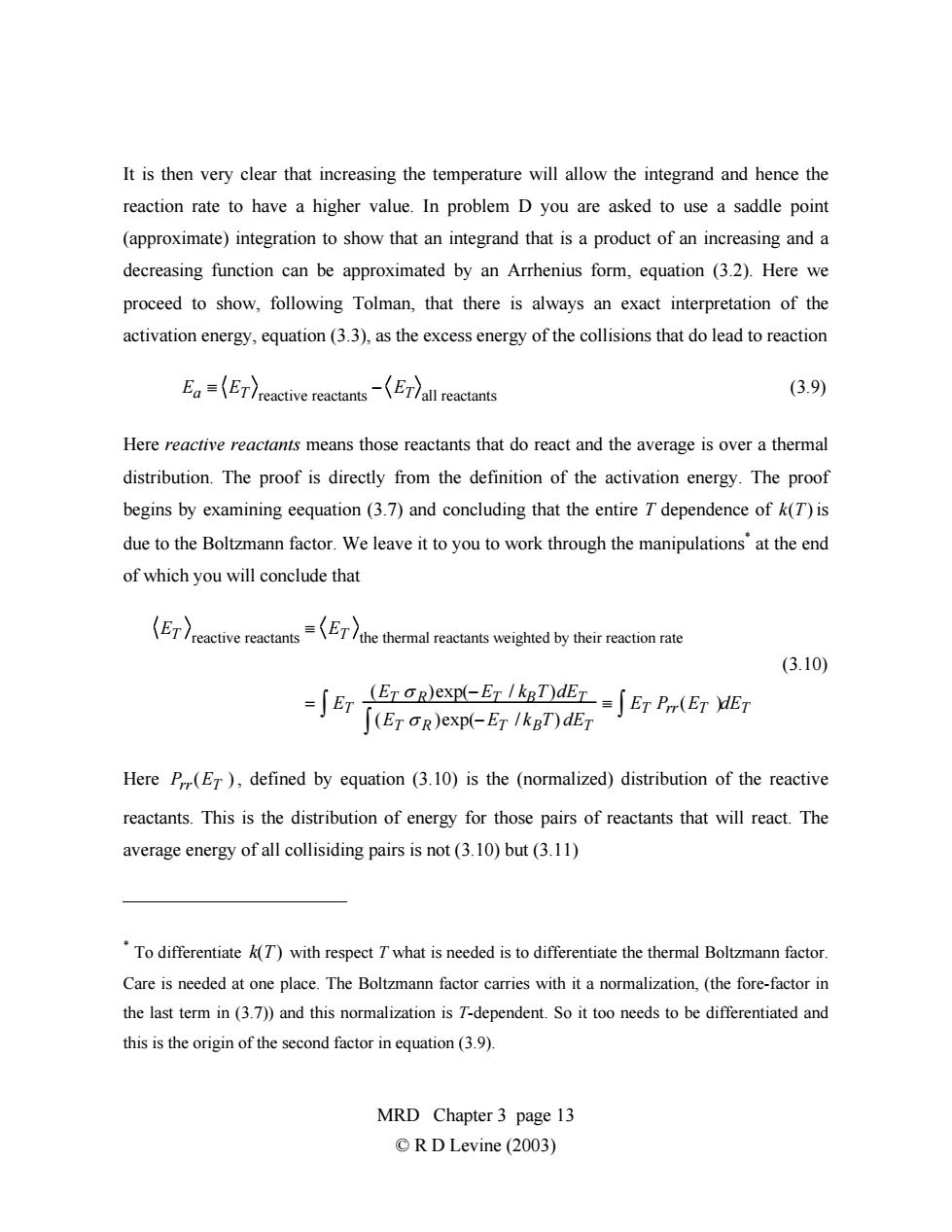正在加载图片...

It is then very clear that increasing the temperature will allow the integrand and hence the reaction rate to have a higher value.In problem D you are asked to use a saddle point (approximate)integration to show that an integrand that is a product of an increasing and a decreasing function can be approximated by an Arrhenius form,equation (3.2).Here we proceed to show,following Tolman,that there is always an exact interpretation of the activation energy,equation(3.3),as the excess energy of the collisions that do lead to reaction EaETreactive reactantsETallreactants (3.9) Here reactive reactants means those reactants that do react and the average is over a thermal distribution.The proof is directly from the definition of the activation energy.The proof begins by examining eequation (3.7)and concluding that the entire T dependence of k(T)is due to the Boltzmann factor.We leave it to you to work through the manipulations at the end of which you will conclude that ctive reactantsthe thermal reactat weighe by their raction ae (3.10) (ET aR)exp-ErIkpT)dErET P(ET YET -E红(Er e-er Here P(ET),defined by equation (3.10)is the (normalized)distribution of the reactive reactants.This is the distribution of energy for those pairs of reactants that will react.The average energy of all collisiding pairs is not (3.10)but(3.11) To differentiate k(T)with respect Twhat is needed is to differentiate the thermal Boltzmann factor. Care is needed at one place.The Boltzmann factor carries with it a normalization,(the fore-factor in the last term in(3.7))and this normalization is T-dependent.So it too needs to be differentiated and this is the origin of the second factor in equation(3.9). MRD Chapter 3 page 13 ©R D Levine(2003)It is then very clear that increasing the temperature will allow the integrand and hence the reaction rate to have a higher value. In problem D you are asked to use a saddle point (approximate) integration to show that an integrand that is a product of an increasing and a decreasing function can be approximated by an Arrhenius form, equation (3.2). Here we proceed to show, following Tolman, that there is always an exact interpretation of the activation energy, equation (3.3), as the excess energy of the collisions that do lead to reaction Ea ≡ ET reactive reactants − ET all reactants (3.9) Here reactive reactants means those reactants that do react and the average is over a thermal distribution. The proof is directly from the definition of the activation energy. The proof begins by examining eequation (3.7) and concluding that the entire T dependence of k(T) is due to the Boltzmann factor. We leave it to you to work through the manipulations* at the end of which you will conclude that ET reactive reactants ≡ ET the thermal reactants weighted by their reaction rate = ET (ET σ R)exp(−ET / kBT)dET ∫ (ET σ R )exp(−ET / kBT) dET ∫ ≡ ET Prr(ET ) ∫ dET (3.10) Here Prr(ET ) , defined by equation (3.10) is the (normalized) distribution of the reactive reactants. This is the distribution of energy for those pairs of reactants that will react. The average energy of all collisiding pairs is not (3.10) but (3.11) * To differentiate k(T) with respect T what is needed is to differentiate the thermal Boltzmann factor. Care is needed at one place. The Boltzmann factor carries with it a normalization, (the fore-factor in the last term in (3.7)) and this normalization is T-dependent. So it too needs to be differentiated and this is the origin of the second factor in equation (3.9). MRD Chapter 3 page 13 © R D Levine (2003)